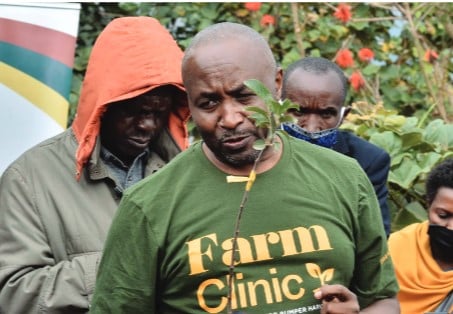Naro playing a catalytic role in kicking poverty out

Denis Ashaba, a researcher at Naro Kachwekano, teaches about apple growing. PHOTO/ GEORGE KATONGOLE
What you need to know:
- Key enterprises include potatoes, apples, dairy cattle, goat and fish. Research outputs and services on other enterprises such as cereals climbing beans, tea, coffee, Hass avocado and piggery required by the residents of Kigezi are sourced from sister institutes of Naro located in other regions of the country.
Kachwekano Zonal Agricultural Research and Development Institute (KaZARDI) is one of the 16 public agricultural research institutes (PARIs) of the National Agricultural Research Organisation (Naro).
KaZARDI’s mandate is to deliver research products and services for the communities of the of South Western Highland Agro Ecological Zone (SWHAEZ).KaZARDI conducts research, agri-technology development and dissemination through three institutional programmes; crops and natural resources research programme, animal resource research programme and technology promotion and outreach programme.The institute is tasked to generate and promote technologies on crops and animals that suit a semi-template climatic condition characteristic of the Kigezi Highlands.
Key enterprises
Key enterprises include potatoes, apples, dairy cattle, goat and fish. Research outputs and services on other enterprises such as cereals climbing beans, tea, coffee, Hass avocado and piggery required by the residents of Kigezi are sourced from sister institutes of Naro located in other regions of the country.
These research products and services are delivered to technology uptake pathways through farmer cooperative societies, faith-based organizations, local government and NGOs via the KaZARDI’s technology promotion and outreach programme.The SWHAEZ is dominated by high altitude areas, in the districts of Kabale, Kanungu, Kisoro, Rubanda, Rukiga and Rukungiri but also stretch to Rwanda and Eastern Democratic Republic of Congo (DRC).
A few areas lie in lowland altitudes of Kihiihi and Bwambara found in the northern parts in Kanungu and Rukungiri districts respectively, neighbouring the Queen Elizabeth National Park. The high-altitude areas are characterised by steep slopes, degraded agricultural systems dominated by annual crops, limited perennial crops, hardly any grazing systems, scanty agro-forestry and low input farming systems.
Exhausted soils
The average size of land holding is about 1.5 acres, which have been continuously cropped over decades resulting in exhausted soils, declining crop productivity, and poverty.
With changing and un-predictable climatic conditions, the system is increasingly becoming prone to high nutrient mining and soil erosion making it highly unproductive, gravely unable to deliver much needed services to sustain the ever-increasing population.
The communities in the Kigezi highlands are hence categorized by Uganda’s Bureau of Statistics, among Uganda communities with highest poverty incidences after Karamoja, Northern and Eastern Uganda. Government of Uganda has for long been undertaking efforts such as Parish Development Model, the Myoga scheme, the Entandikwa scheme, Boona Bagagawale, among others; to fight poverty, food and nutritional insecurity as well as high environmental degradation in the highland communities, with little success.
NARO through its zonal Institute based in Kachwekano near Kabale is strategically placed to play a catalytic role in the transformation of the communities residing in the Kigezi highlands. This transformation agenda kicks off with addressing the degradation of the slopes.
Destroyed terraces
The terraces are increasingly being destroyed resulting in rampant landslides and the swamps get flooded. Naro has kick started restoration of terraces on Kigezi hills with establishment of reversed bench terraces at Kachwekano stabilised with water harvesting structures and e communities in Kabale, Rubanda and Rukiga Districts to demonstrate their benefits, against the costs of their restoration. The trapped rain water on the slope support production of crops and animal life, resulting in compounded yield benefits for the farmers, especially if planted with very high-value crops such as potatoes, apples and horticultural crops.
Reverse terraces planted with various high value crops at the Kachwekano hill, Rubanda District. For example, a half an acre of well managed Naro potato variety (NAROPOT 4 aka Rwangume) yields a minimum of 40 bags in just four months after planting generating approximately Shs6m, at a grossly under-priced value of Shs150,000 per bag. To harness the potential of potato as a cash cow for Kigezi highland farming communities, Naro has developed better yielding, disease resistant and processing potato varieties that yield 60 bags per acre.
These new varieties earn an additional Shs3m, and yet cost less in fungicide sprays for late blight management, saving about Shs650,000, increasing the total additional benefit of Shs3.65m. This means a farmer stands to obtain over Shs18m per acre of potato in just four months.
Improved varieties
KaZARDI promotes the improved varieties with the appropriate production package required to achieve the premised yield in terms of fertiliser application, pests and diseases management and other agronomic practices.
These new varieties have been tested by large scale potato crisps processor; Sumz and chips outlets especially high-end hotels and found suitable and recommended for large scale production for processing. This implies their market will continue on its upward trend for the emerging and expanding market of chips and crisps among the ever-increasing youthful consumers in the upcoming urban centres within the East African region.
There are other crops such as cabbages, onions and other horticultural crops that are able to generate good amount of money within small but terraced land pieces, offering value as rotational crops for disease management in potato farming systems. Farmers should adopt intensive production systems to obtain the maximum output possible.
There are other high value cropping systems that are transformational in nature such as the perennial cropping systems of multipurpose trees like coffee, Hass avocadoes, apples macadamia and peers. These tree crops are suitable for the hillside pieces of land that have for long been occupied by eucalyptus.
The writer, DR JEROME KUBIRIBA, is director of research KaZARDI.




